Woman of the West Tapestry
The Woman of the West Tapestry is located in the Bland Shire council building in West Wyalong, a small town in central NSW, in Australia. The tapestry is a tribute to the pioneer women of the Shire, and is a hand spun, hand dyed, handwoven woollen wall hanging (252cm x 228cm). It was a project of the Bland Spinners and Weavers Group for Australia’s bicentennial celebration in 1988 and was gifted to the residents of the Shire.
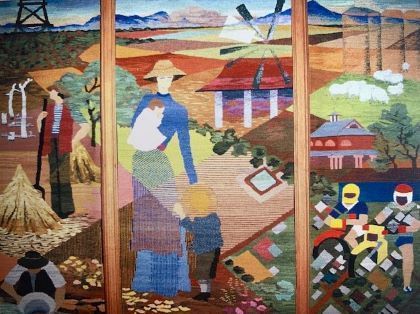
Discussions around the theme of the tapestry began in 1983. During the first two years the members attended various courses in spinning, dyeing, and weaving. The Guild engaged Mary Beeston, a fibre artist and designer, together with her weaver husband, Larry, to harness the members' ideas for the tapestry. Both were well known in Hunter region of NSW.
It might be timely to take a small diversion and tell you about a major work created by Mary and Larry Beeston.
The Hunter Tapestry hangs in the Great Hall of the University of Newcastle. The iconic tapestry was designed by Mary Beeston, and woven by her husband, Larry Beeston, with local weaver Rachel Frecker. It was commissioned by the Friends of the University who gifted it to the University in 1988.
The 18-metre long x 2.5m high tapestry comprises 12 panels that chronicle the history of the Hunter Valley. Each panel depicts a different chapter from the prehistoric volcanic age through to the founding of the University. Running through the entire tapestry is the river of life.
The photograph below was digitally remastered and put together from several photographs taken by Charles Hardy.1

The panel on the front cover of the Newcastle University (Australia) 2010 Annual report tells the story of the arrival of Indigenous communities to the region, and the panel on the back cover depicts the establishment of the city of Newcastle.1
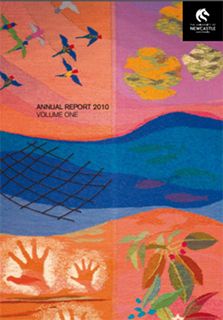
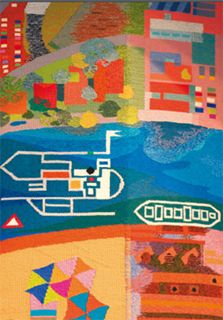
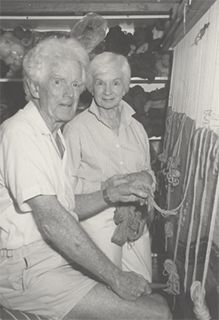
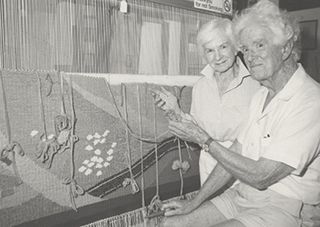
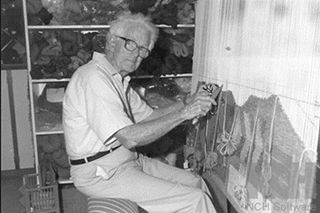
Back to the Woman of the West tapestry. To aid in the design, an aerial inspection of the town and surrounding district was undertaken to enable them to develop colour and design ideas. Mary dealt with the intricacies of ‘hot and ‘cold’ design, while Larry introduced many members to tapestry weaving techniques. Three large looms were constructed by Glen Adler and 40kg of “Romney marsh"^ fleece was sourced from Grenfell graziers Robin and Judy Baker. This was duly carded, spun, dyed and finally woven. The weaving process took 18 months to complete and ultimately was awarded a silver medal in the Women’s Weekly magazine competition ‘Women Celebrate 88.’
^The Romney (originally called Romney Marsh) is one of the oldest known sheep breeds, with its origins having been traced back more than 700 years to the 13th century and possibly earlier.2
As seen above, the tapestry consists of three large panels:
Panel 1 (below) depicts the early settlement of Wyalong and West Wyalong, featuring farming, the 1890s gold diggings and the openness of the mallee^ country and western sky.
^ Mallee lands, characterised by multi-stemmed eucalypts, occur across southern Australia, generally on wind-formed (aeolian) landforms, with sandy soils. Drought is a fact of life in these areas, and the rainfall will often be less than 100 mm per year.3
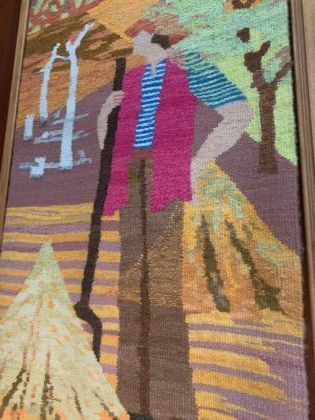
Panel 2 (below) is a tribute to pioneer women, with the mural’s central figure being a woman seen holding a young girl, with an older boy by her side.

Panel 3 represents the modern town c1980, complete with the overlay of bike riders and the town’s distinctive iron roofs, trees, parks, and public buildings.
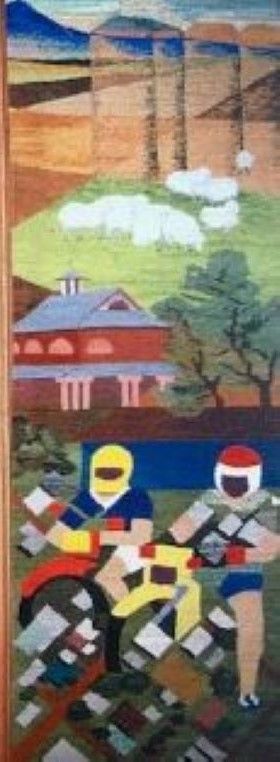
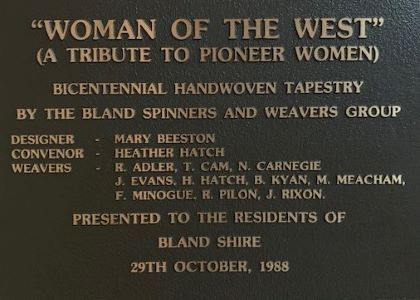
Editor's Note
A huge shout out to G.C. in Indiana USA and H.H. in Australia who have joined us - welcome aboard.
And the June Mailbag is filling up - but still a little room if you have a favourite image to send to us to share with the AnArt4Life community.
Footnotes
All photos my own unless otherwise stated
- newcastle.edu.au - annual report 2010
- rarebreedproject.com/romney
- environment.nsw.gov.au
